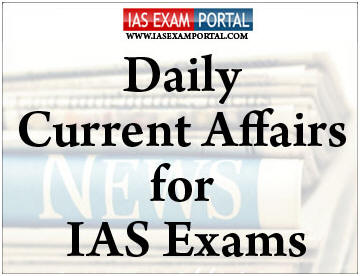(HOT) UPSC Current Affairs 2025 PDF
NEW! The Gist (NOV-2025) | E-BOOKS
Current Affairs for IAS Exams - 13 October 2022

Current Affairs for IAS Exams - 13 October 2022
::NATIONAL::
Arth-Ganga
- PM Modi first introduced the concept during the first National Ganga Council meeting in Kanpur in 2019, where he urged for a shift from NamamiGange, the Union Government’s flagship project to clean the Ganga, to the model of Arth-Ganga.
About:
- Arth-Ganga focuses on the sustainable development of the Ganga and its surrounding areas, by focusing on economic activities related to the river.
- At its core, the Arth-Ganga model seeks to use economics to bridge people with the river.
- During his keynote address, Asok Kumar stated that it “strives to contribute at least 3% of the GDP from the Ganga Basin itself,” and added that the Arth Ganga project’s interventions are in accordance with India’s commitments towards the UN sustainable development goals.
- Therefore Arth-Ganga concept can be summarised as a river-people connection through the economic bridge to ensure the sustainability of these activities under “NamamiGange”, the flagship programme of the Government to clean Ganga and its tributaries.
What are the “six vertical” features of Arth Ganga?
- Under Arth Ganga, the government is working on six verticals.
- The first is Zero Budget Natural Farming, which involves chemical-free farming on 10 km on either side of the river, and the promotion of cow dung as fertiliser through the Gobardhan scheme.
- The Monetization and Reuse of Sludge and Wastewater is the second, which seeks to reuse treated water for irrigation, industries and revenue generation for Urban Local Bodies (ULBs).
- Arth Ganga will also involve Livelihood Generation Opportunities, by creating haats where people can sell local products, medicinal plants and ayurveda.
- The fourth is to increase public participation by increasing synergies between the stakeholders involved with the river.
CLICK HERE FOR FULL CURRENT AFFAIRS (Only for Course Members)
Gorkhas in Indian Army
- Nepal has postponed the recruitment rallies which were to be held in that country to recruit Gorkha soldiers for the Indian Army under the Agnipath scheme.
About:
- The decision to postpone these rallies has been taken by the Nepalese government as it is of the opinion that this new form of entry into the Indian military is not covered under the Tripartite Agreement signed between Nepal, Indian and UK governments in 1947, soon after Indian independence.
- As per the terms of this agreement four regiments of Gorkha soldiers – 2nd, 6th, 7th and 10th – were transferred to the British Army while the rest – 1st, 3rd, 4th, 5th, 8th and 9th – remained with the Indian Army.
- A new Gorkha Regiment, the 11th Gorkha Rifles, was raised by India soon after Independence.
- The agreement also provides for the terms and conditions of the Nepal-domiciled Gorkha soldiers in the Indian Army and for their post-retirement benefits and pensions.
JOIN Full Online Course for UPSC PRE Exam
UPSC IAS Exam Complete Study Materials
::INTERNATIONAL::
Horn of Africa
- The World Meteorological Organization (WMO) has said that a fifth consecutive failed rainy season is expected to deepen the drought crisis faced in the Horn of Africa as the worst drought in more than 40 years looks almost certain to persist.
About:
- It constitutes the peninsula of northeast Africa and is the easternmost extension of the African continent separating the Gulf of Aden from Indian Ocean.
- Generally, it consists of Djibouti, Eritrea, Ethiopia, and Somalia.
- Surrounded by the Red Sea, Gulf of Aden, and Indian Ocean.
- It is made up of a wedge of land that is cut north to south by two great geographical features: Nile Valley and Great Rift Valley.
- Between these two features are high plateaus and rugged volcanic mountains.
- West of the White Nile River spans the Sahara Desert.
Seti River
- Nepal has formally awarded the West-Seti Hydropower Project and Seti River Project (SR6)—joint storage projects totalling 1200MW—to India’s National Hydro Power Corporation (NHPC) on August 18.
About:
- The projects will be a storage system that produces power all year round. Through its national grid, India will receive the power, either for its own use or for export.
- Seti (meaning white river), also known as Seti Gandaki, is a Western Nepal river which originates at Annapurna Massif.
CLICK HERE FOR FULL CURRENT AFFAIRS (Only for Course Members)
::ECONOMY::
50 percent of India’s energy production will be met by non-fossil fuel by 2030
- Prime Minister Narendra Modi has said that by 2030, 50 percent of India’s energy production will be met by non-fossil fuel, and by 2070 it plans ‘Net Zero’.
About:
- PM Modi said that a silent revolution is taking shape in India with rising demand for electric vehicles (EV).
- Prime Minister was addressing a function at Gandhinagar to mark on the completion of 40 years of Suzuki Motor Corp in India.
- Meanwhile, Suzuki Motor Corporation president Toshihiro Suzuki has announced the setting up of a new company, Suzuki R&D Centre India, a wholly-owned arm of Suzuki Japan.
CLICK HERE FOR FULL CURRENT AFFAIRS (Only for Course Members)
::SCIENCE AND TECHNOLOGY::
Small Cells
- To expedite the roll-out of 5G, telecom operators in the country will leverage street furniture such as poles, advertisement hoardings and bus shelters for deploying low-power base stations called ‘small cells’ that will help bring the network closer to the consumers.
About:
- Small cells are needed for deploying 5G as opposed to earlier generations such as 4G, because of the frequency. The higher the frequency, the lower the wavelength, which means that the distance they travel is less.
- Small cells are low-powered radio access nodes or base stations that have a coverage range from a few metres up to a few hundred metres. They are portable, easy to deploy and help provide localised coverage.
CLICK HERE FOR FULL CURRENT AFFAIRS (Only for Course Members)

